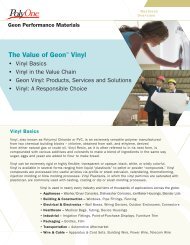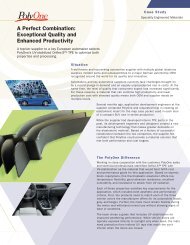PolyOne 2009 Annual Report
PolyOne 2009 Annual Report
PolyOne 2009 Annual Report
You also want an ePaper? Increase the reach of your titles
YUMPU automatically turns print PDFs into web optimized ePapers that Google loves.
POLYONE CORPORATION<br />
We engage in acquisitions and joint ventures, and may encounter<br />
unexpected difficulties integrating those businesses.<br />
Attainment of our strategic plan objectives may require, in part,<br />
strategic acquisitions or joint ventures intended to complement or<br />
expand our businesses globally or add product technology that<br />
accelerates our specialization strategy, or both. Success will<br />
depend on our ability to complete these transactions or arrangements,<br />
and integrate the businesses acquired in these transactions<br />
as well as develop satisfactory working arrangements with our<br />
strategic partners in the joint ventures. Unexpected difficulties in<br />
completing and integrating acquisitions with our existing operations<br />
and in managing strategic investments could occur. Furthermore,<br />
we may not realize the degree, or timing, of benefits initially anticipated,<br />
which could adversely affect our business, financial position,<br />
results of operations or cash flows.<br />
Our results of operations may be adversely affected by the<br />
results of operations of SunBelt.<br />
SunBelt is our largest equity investment. The earnings of this<br />
partnership may be significantly affected by changes in the commodity<br />
cycle for hydrocarbon feedstocks and for chlor-alkali products.<br />
If the profitability of SunBelt is adversely affected, cash<br />
distributions from the partnership may decline or we may be<br />
required to make cash contributions to the partnership, either of<br />
which could adversely affect our financial position, results of operations<br />
or cash flows.<br />
Natural gas, electricity, fuel and raw material costs, and other<br />
external factors beyond our control, as well as downturns in the<br />
home repair and remodeling and new home sectors of the economy,<br />
can cause wide fluctuations in our margins.<br />
The cost of our natural gas, electricity, fuel and raw materials, and<br />
other costs, may not correlate with changes in the prices we receive<br />
for our products, either in the direction of the price change or in<br />
absolute magnitude. Natural gas and raw materials costs represent<br />
a substantial part of our manufacturing energy costs. In particular,<br />
electricity and fuel represent a component of the costs to manufacture<br />
building products. Most of the raw materials we use are<br />
commodities and the price of each can fluctuate widely for a variety<br />
of reasons, including changes in availability because of major<br />
capacity additions or reductions or significant facility operating<br />
problems. Other external factors beyond our control can cause<br />
volatility in raw materials prices, demand for our products, product<br />
prices, sales volumes and margins. These factors include general<br />
economic conditions, the level of business activity in the industries<br />
that use our products, competitors’ actions, international events<br />
and circumstances, and governmental regulation in the United<br />
States and abroad, such as climate change regulation. These factors<br />
can also magnify the impact of economic cycles on our business.<br />
While we attempt to pass through price increases in energy<br />
costs and raw materials, we have been unsuccessful in doing so in<br />
some circumstances in the past and there can be no reassurance<br />
that we can do so in the future.<br />
Additionally, our products used in housing, transportation and<br />
building and construction markets are impacted by changes in<br />
demand in these sectors, which may be significantly affected by<br />
changes in economic and other conditions such as gross domestic<br />
product levels, employment levels, demographic trends, legislative<br />
actions and consumer confidence. These factors can lower the<br />
demand for and pricing of our products, which could cause our net<br />
sales and net income to decrease.<br />
We face competition from other polymer and chemical companies,<br />
which could adversely affect our sales, results of operations<br />
or cash flows.<br />
We actively compete with companies that produce the same or<br />
similar products, and in some instances with companies that produce<br />
different products that are designed for the same end uses.<br />
We encounter competition in price, delivery, service, performance,<br />
product innovation, product recognition and quality, depending on<br />
the product involved.<br />
We expect that our competitors will continue to develop and<br />
introduce new and enhanced products, which could cause a decline<br />
in the market acceptance of our products. In addition, our competitors<br />
could cause a reduction in the selling prices of some of our<br />
products as a result of intensified price competition. Competitive<br />
pressures can also result in the loss of major customers. An inability<br />
to compete successfully could have an adverse effect on our financial<br />
position, results of operations or cash flows.<br />
We may also experience increased competition from companies<br />
that offer products based on alternative technologies and<br />
processes that may be more competitive or better in price or<br />
performance, causing us to lose customers and result in a decline<br />
in our sales volume and earnings.<br />
Additionally, some of our customers may already be or may<br />
become large enough to justify developing in-house production<br />
capabilities. Any significant reduction in customer orders as a result<br />
of a shift to in-house production could adversely affect our sales and<br />
operating profits.<br />
A major failure of our information systems could harm our<br />
business.<br />
We depend on integrated information systems to conduct our business.<br />
We may experience operating problems with our information<br />
systems as a result of system failures, viruses, computer “hackers”<br />
or other causes. Any significant disruption or slowdown of our<br />
systems could cause customers to cancel orders or cause standard<br />
business processes to become ineffective, which could adversely<br />
affect our financial position, results of operations or cash flows.<br />
Adverse credit market conditions may significantly affect our<br />
access to capital, cost of capital and ability to meet liquidity<br />
needs.<br />
Disruptions, uncertainty or volatility in the credit markets may<br />
adversely impact our ability to access credit already arranged<br />
10





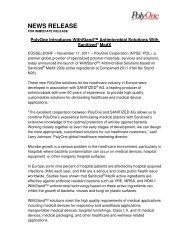

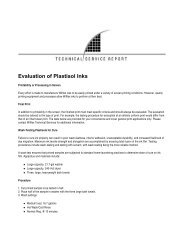
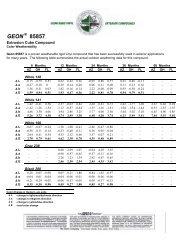
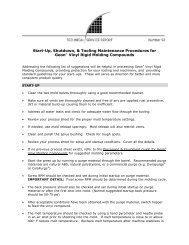
![TPE Injection Molding Guide [PDF] - GLS Thermoplastic Elastomers](https://img.yumpu.com/26329362/1/190x245/tpe-injection-molding-guide-pdf-gls-thermoplastic-elastomers.jpg?quality=85)




